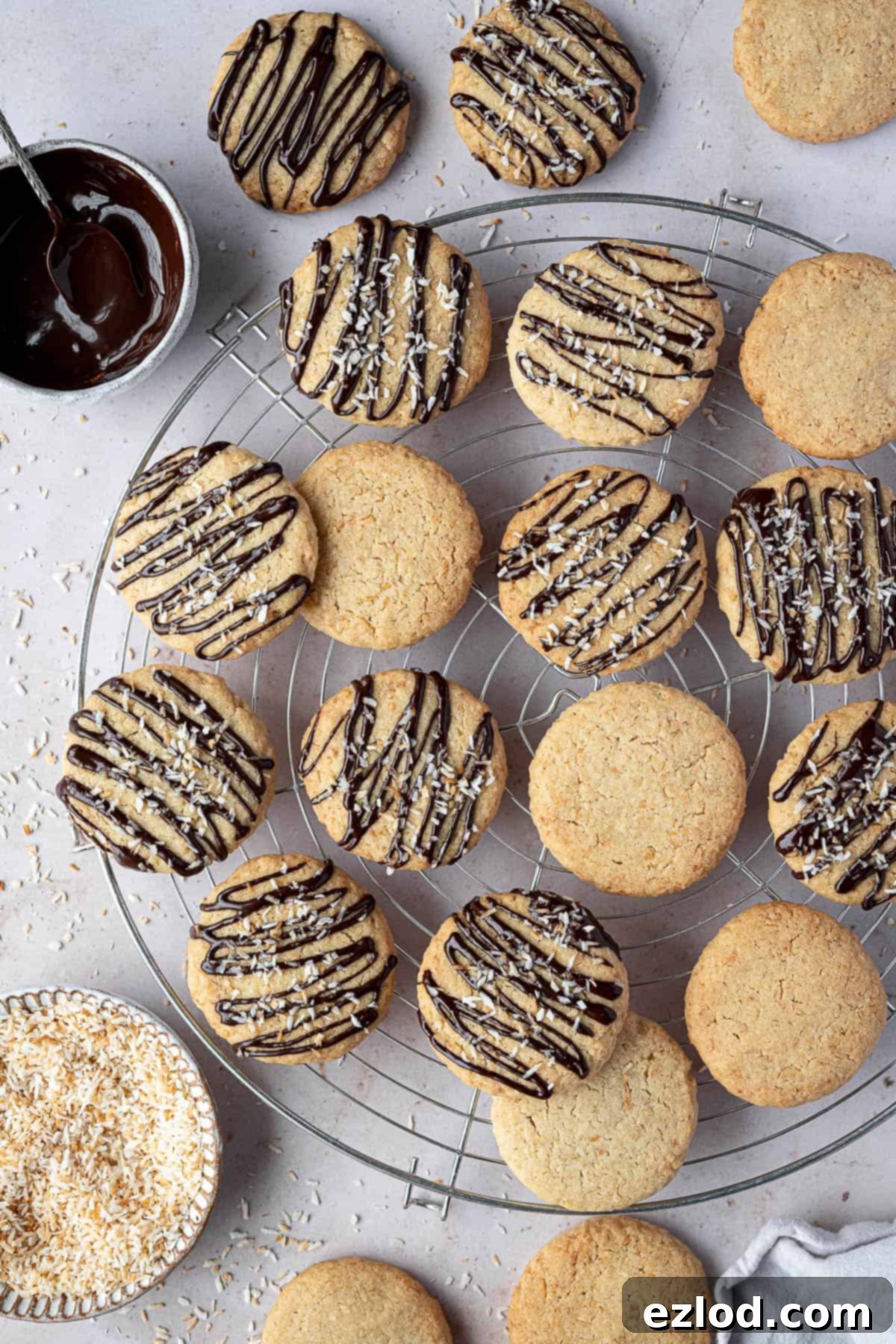Irresistible Vegan Coconut Cookies: Crispy, Chewy & Chocolate Drizzled Perfection
Prepare to fall in love with these delightful vegan coconut cookies! They’re not just any cookies; they’re a revelation for plant-based baking enthusiasts and a treat for anyone who enjoys a perfectly balanced biscuit. Imagine a shortbread-style cookie that’s wonderfully crisp on the outside, yielding to a tender, slightly soft interior, all infused with the exotic, nutty aroma of toasted coconut. And for an extra touch of indulgence, a luscious drizzle of melted dark chocolate elevates them from an everyday delight to a truly special occasion treat. These utterly moreish cookies are incredibly easy to make, yet they taste like they came straight from a gourmet bakery.
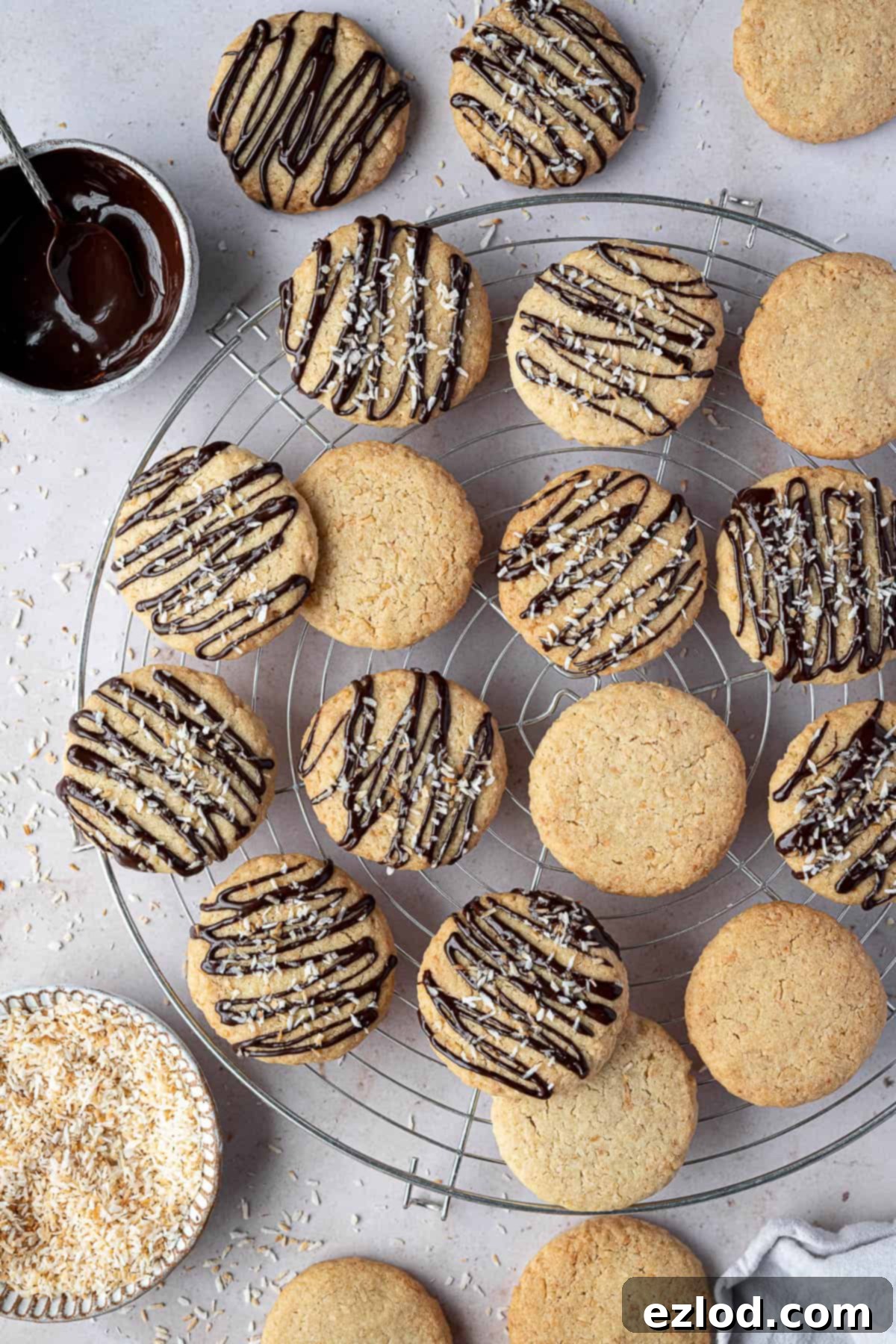
What makes these vegan coconut cookies truly stand out is the intentional preparation of the star ingredient: coconut. By toasting the desiccated coconut before incorporating it into the dough, we unlock a deeper, richer, and more intense flavor profile that sweetens the entire cookie with a natural, caramelized note. This simple step transforms the ordinary into the extraordinary, ensuring every bite is bursting with tropical goodness. While these cookies are perfect on their own, a generous drizzle of high-quality melted dark chocolate and an optional sprinkle of extra toasted coconut not only adds a beautiful visual appeal but also introduces a decadent layer of flavor and texture. It’s the kind of subtle luxury that makes these cookies perfect for gifting, entertaining, or simply enjoying with a warm cup of coffee or tea.
Beyond being a fantastic everyday cookie, their delicate flavor and elegant presentation make them an ideal candidate for special occasions. Imagine them gracing your Easter table, tucked into a picnic basket, or served as a delightful dessert after a family meal. They are universally loved and suit a variety of dietary preferences, ensuring everyone can enjoy a truly delicious treat. This recipe is a carefully adapted and veganized version of a classic BBC Good Food recipe, ensuring reliable results and maximum flavor.
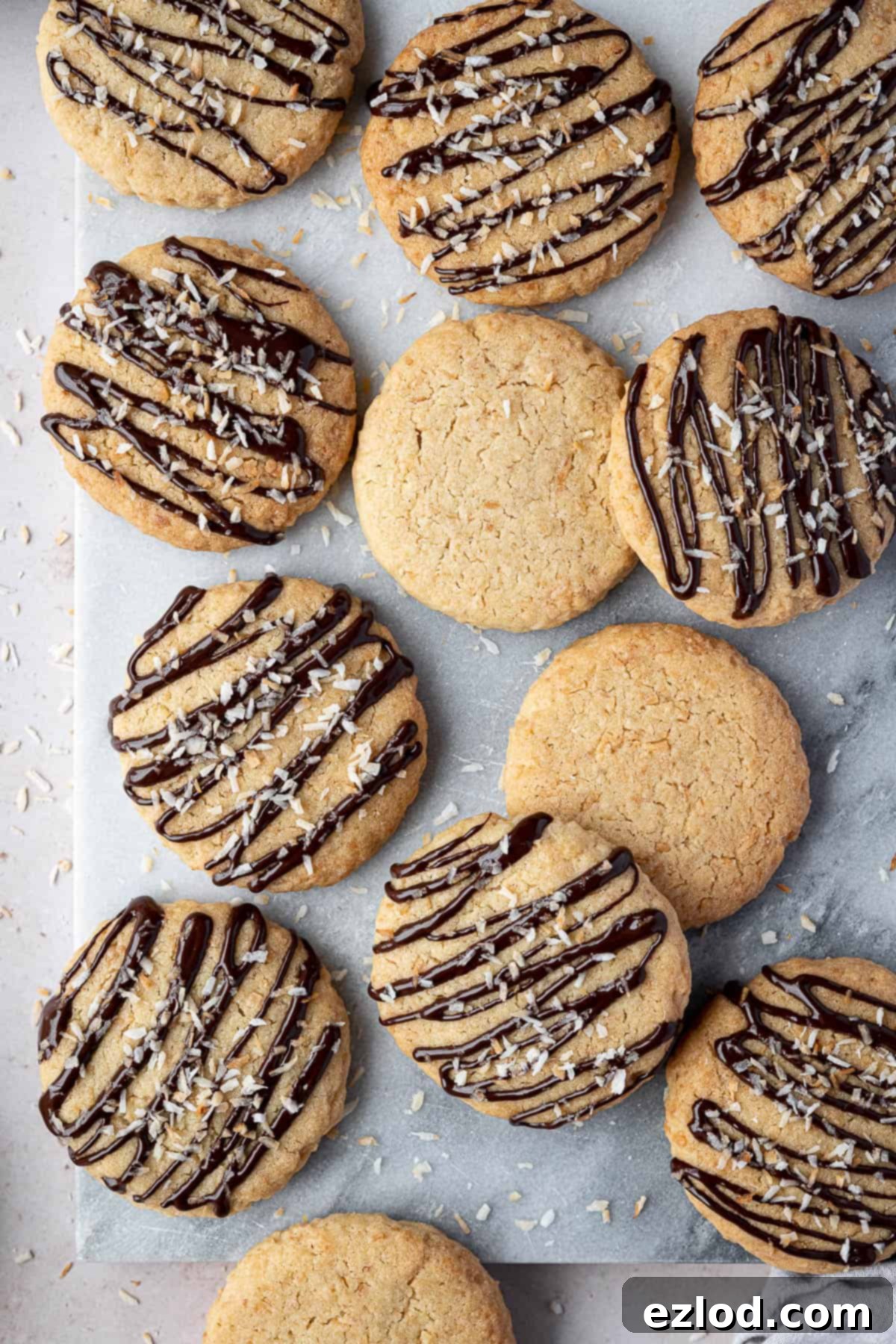
Essential Ingredients for Perfect Vegan Coconut Cookies:
Crafting these delectable vegan coconut cookies requires a few key ingredients, each playing a crucial role in achieving that perfect balance of flavor and texture. Choosing the right type of each component is essential for a successful bake. Here’s a detailed look at what you’ll need:
- Vegan Block Butter: This is arguably the most critical ingredient. For the love of holy baking, please use a high-quality block butter or margarine, not the spreadable kind that comes in a tub. Spreadable vegan margarines often contain a higher water content and lower fat percentage, which can lead to a dough that’s too soft, making it difficult to handle and resulting in tougher, less tender cookies. Block butter, designed for baking, has a similar fat content to traditional dairy butter, ensuring your cookies achieve that desired crisp-on-the-outside, soft-in-the-middle texture. Brands like Naturli Vegan Block or Flora Plant Butter are excellent choices known for their performance in vegan baking. Ensure your butter is slightly softened at room temperature, but not melted, for optimal creaming.
- Plain Flour (All-Purpose Flour): Standard plain (all-purpose) flour is perfectly suited for this recipe. It provides the necessary structure without making the cookies overly dense. While I haven’t specifically tested a gluten-free version, if you wish to experiment, a good quality gluten-free all-purpose baking blend (often containing xanthan gum) would be the most suitable substitute, though the final texture may vary.
- Desiccated Coconut: This is the heart of our cookie! Make sure to use unsweetened desiccated coconut. Sweetened coconut often contains added sugars and humectants that can alter the dough’s moisture content and overall sweetness, potentially leading to an overly sweet or gummy cookie. The natural sweetness of the coconut is enhanced through toasting, and we control the added sugar separately.
- Non-Dairy Milk: Any unsweetened non-dairy milk will work beautifully to bind the dough and add a touch of moisture. Soy milk is my preferred choice due to its creamy texture and neutral flavor, but almond, oat, or cashew milk would also be suitable. Ensure it’s unsweetened to avoid unexpected sweetness in your cookies.
- Vanilla Extract: A good quality vanilla extract is essential for enhancing the overall flavor profile of the cookies, complementing the coconut beautifully. It adds warmth and depth. If you happen to have vanilla bean paste, it would be an absolutely incredible alternative, offering a more intense and complex vanilla aroma with visible flecks of vanilla bean.
- Sugar Blend (Caster & Light Brown Soft Sugars): I recommend using a blend of caster (or granulated) sugar and light brown soft sugar. Caster sugar contributes to the crispness of the cookies, while light brown soft sugar adds moisture, a subtle caramel note, and a chewier texture. Using both creates a wonderfully balanced cookie. You can certainly use all of one or the other, but be aware that it will slightly alter the final texture: all caster sugar will result in a crisper cookie, while all brown sugar will yield a softer, chewier one.
- Dark Chocolate: This is an optional but highly recommended addition. While the vegan coconut cookies are wonderfully delicious on their own, a drizzle of melted dark chocolate elevates them significantly. It adds a sophisticated touch, a hint of bitterness that perfectly contrasts the sweet coconut, and transforms them from a simple biscuit to a fancy, dessert-worthy treat. Ensure you choose a dark chocolate that is explicitly labeled vegan or dairy-free.
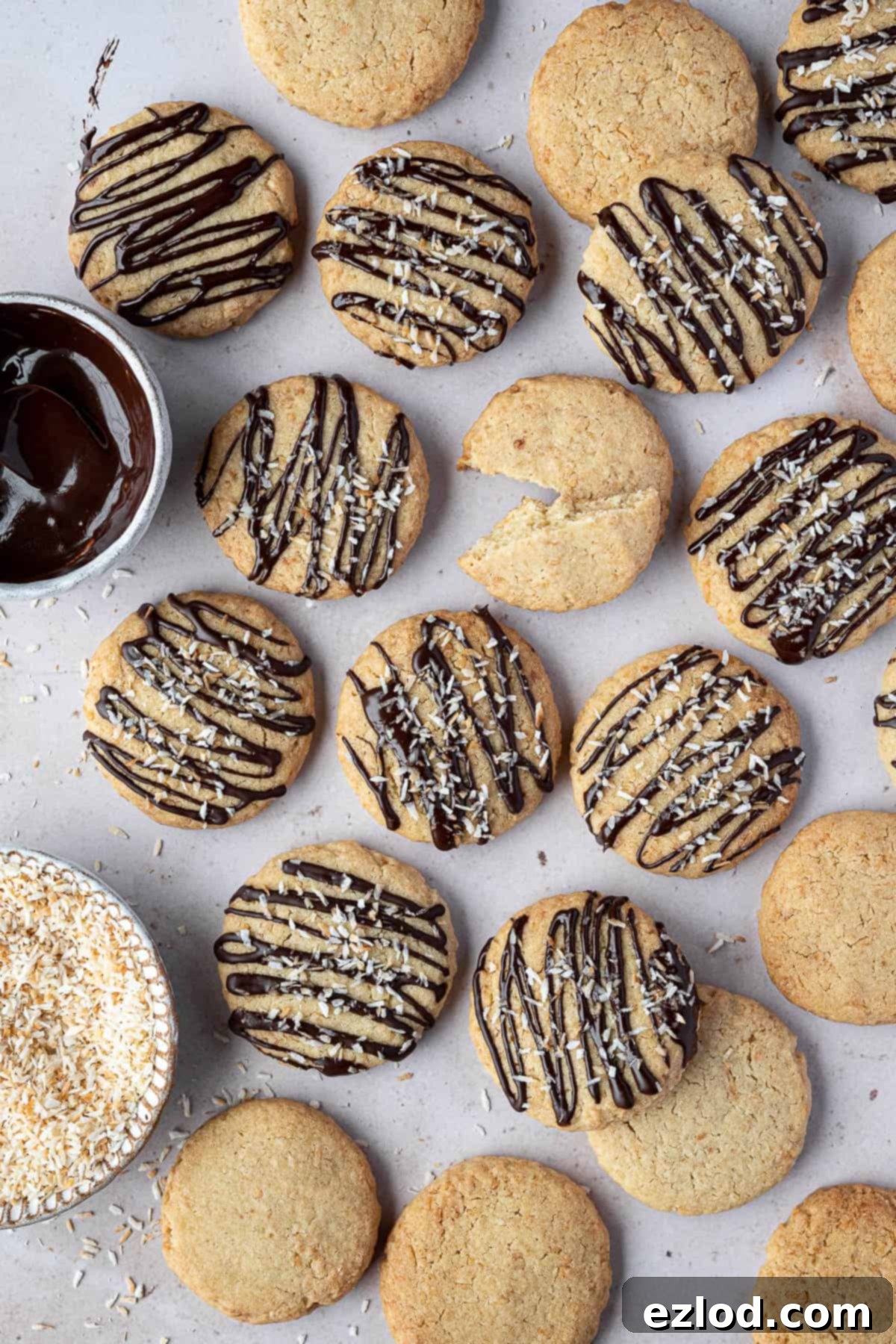
Crafting Your Vegan Coconut Cookies: A Step-by-Step Guide
(For precise measurements and detailed instructions, please refer to the comprehensive recipe card located at the bottom of this page.)
Making these vegan coconut cookies is a straightforward and enjoyable process. Follow these steps carefully to ensure perfect results every time:
- Toast the Coconut for Ultimate Flavor: Begin by preheating your oven to 180°C/160°C fan/350°F/gas mark 4, and line two baking sheets with baking parchment. This ensures you’re ready for baking once the dough is mixed. Now, the magic step: spread your desiccated coconut evenly in a wide skillet or frying pan. Place it over a low heat and stir continuously. This gentle, even heat prevents burning and allows the coconut to gradually turn a beautiful golden brown. As it toasts, you’ll notice a delightful, rich aroma filling your kitchen – that’s the flavor intensifying! Once golden, immediately remove the pan from the heat, transfer the toasted coconut into a bowl, and set it aside to cool completely. Cooling is crucial to prevent it from melting your vegan butter when added to the dough.
- Cream the Wet Ingredients: In a large mixing bowl, combine the slightly softened vegan block butter, caster sugar, light brown soft sugar, vanilla extract, and non-dairy milk. Using an electric mixer, cream these ingredients together until they are well combined, light, and fluffy. This process incorporates air into the mixture, contributing to the cookies’ tender texture. Scrape down the sides of the bowl as needed to ensure everything is evenly mixed.
- Incorporate Dry Ingredients: Once your wet ingredients are perfectly creamed, gently stir in the cooled toasted coconut. Ensure it’s evenly distributed. Finally, add the plain flour and mix until just combined. It’s important not to overmix the dough once the flour is added, as this can develop the gluten too much, leading to tough rather than tender cookies. Mix just until no streaks of flour remain.
- Shape the Cookie Dough: Roll the dough into approximately 23 uniform balls. Each ball should be about a rounded tablespoon in size, or roughly 32g if you prefer to weigh them for precise consistency – which I highly recommend for even baking. If you find the dough too soft to handle easily, simply cover the bowl and refrigerate it for about 30 minutes; this will help it firm up. Place the shaped dough balls well spaced apart on your lined baking sheets to allow for a little spread.
- Flatten for Perfect Texture: These cookies don’t spread significantly in the oven, so it’s important to flatten them before baking. Use your fingers or the bottom of a glass to gently press down each dough ball to your desired cookie thickness. I aim for about 1cm (approximately ⅜ inch) thick for that ideal crisp-tender balance.
- Bake to Golden Perfection: Bake the flattened cookies in your preheated oven for approximately 20 minutes, or until they are lightly golden around the edges and set in the center. Keep a close eye on them, as oven temperatures can vary. Once baked, transfer the cookies to a wire rack immediately and allow them to cool completely. They will firm up as they cool, achieving that perfect crispness.
- Optional Chocolate Drizzle: Once the cookies are entirely cool, you can proceed with the optional chocolate drizzle. Melt your dark chocolate using a double boiler or in short bursts in the microwave, stirring until smooth. Drizzle the melted chocolate artistically over the cooled cookies using a spoon or a piping bag with a very small hole. For an extra flourish, sprinkle a little more toasted coconut over the wet chocolate before it sets. Allow the chocolate to fully harden before serving or storing.
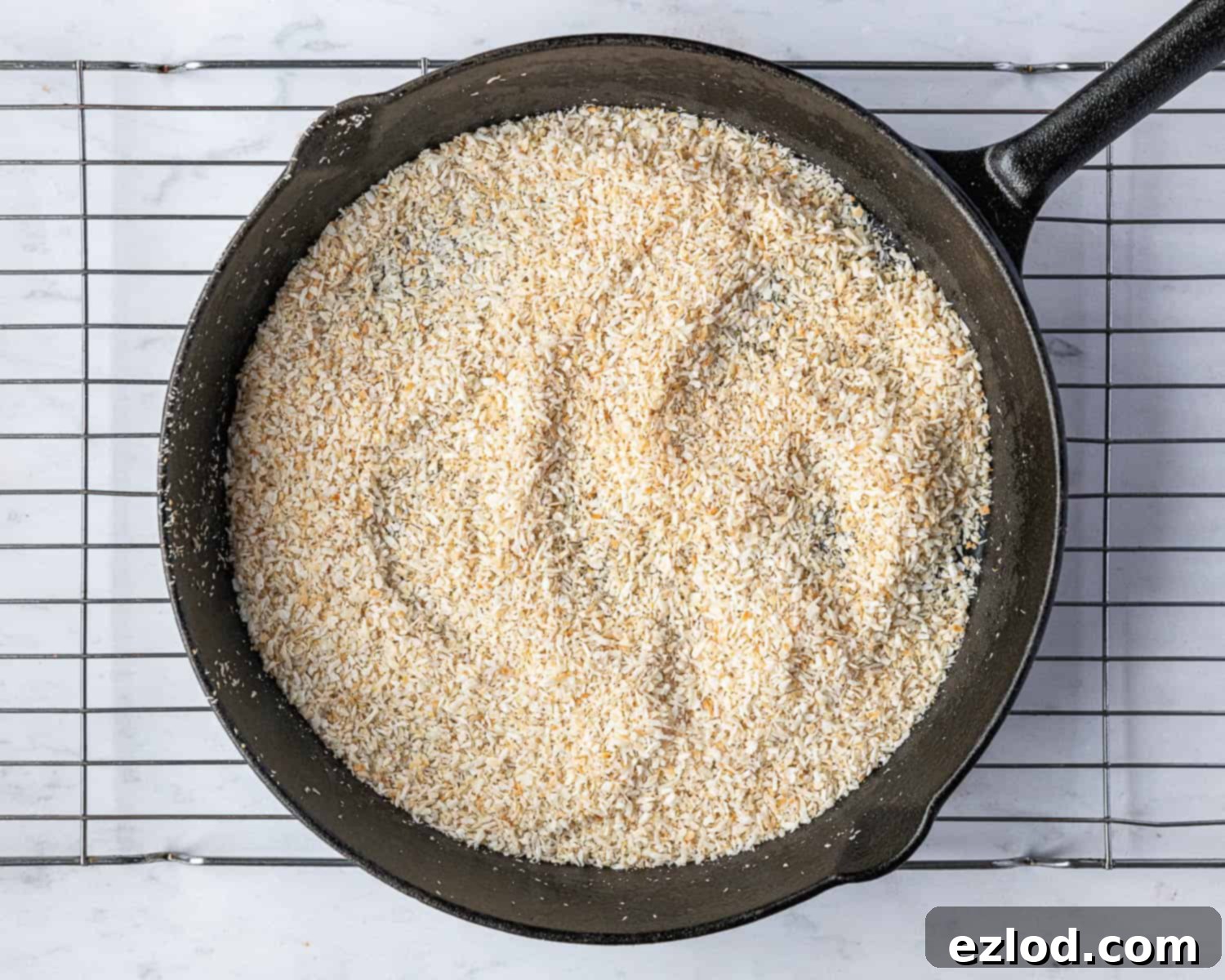
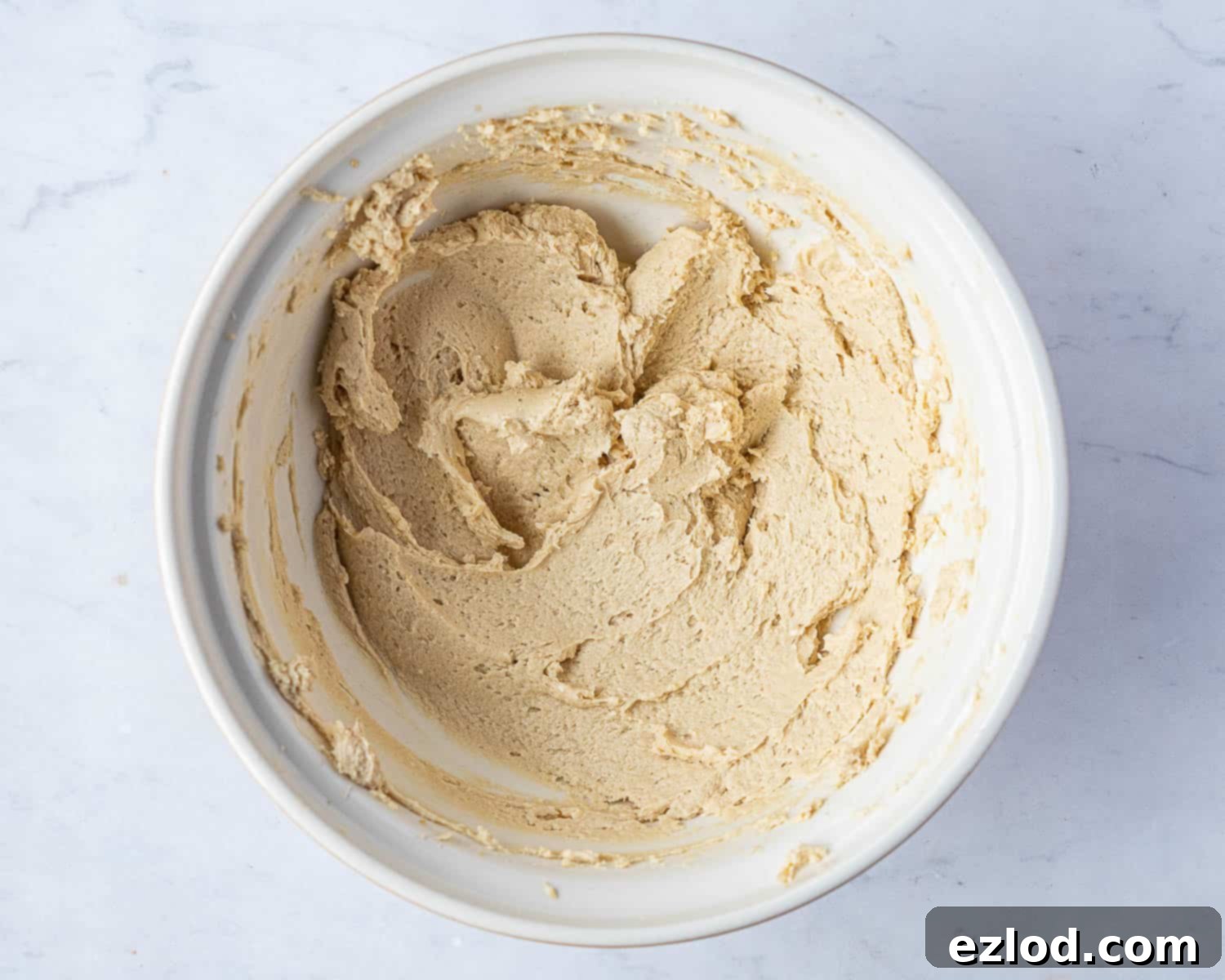
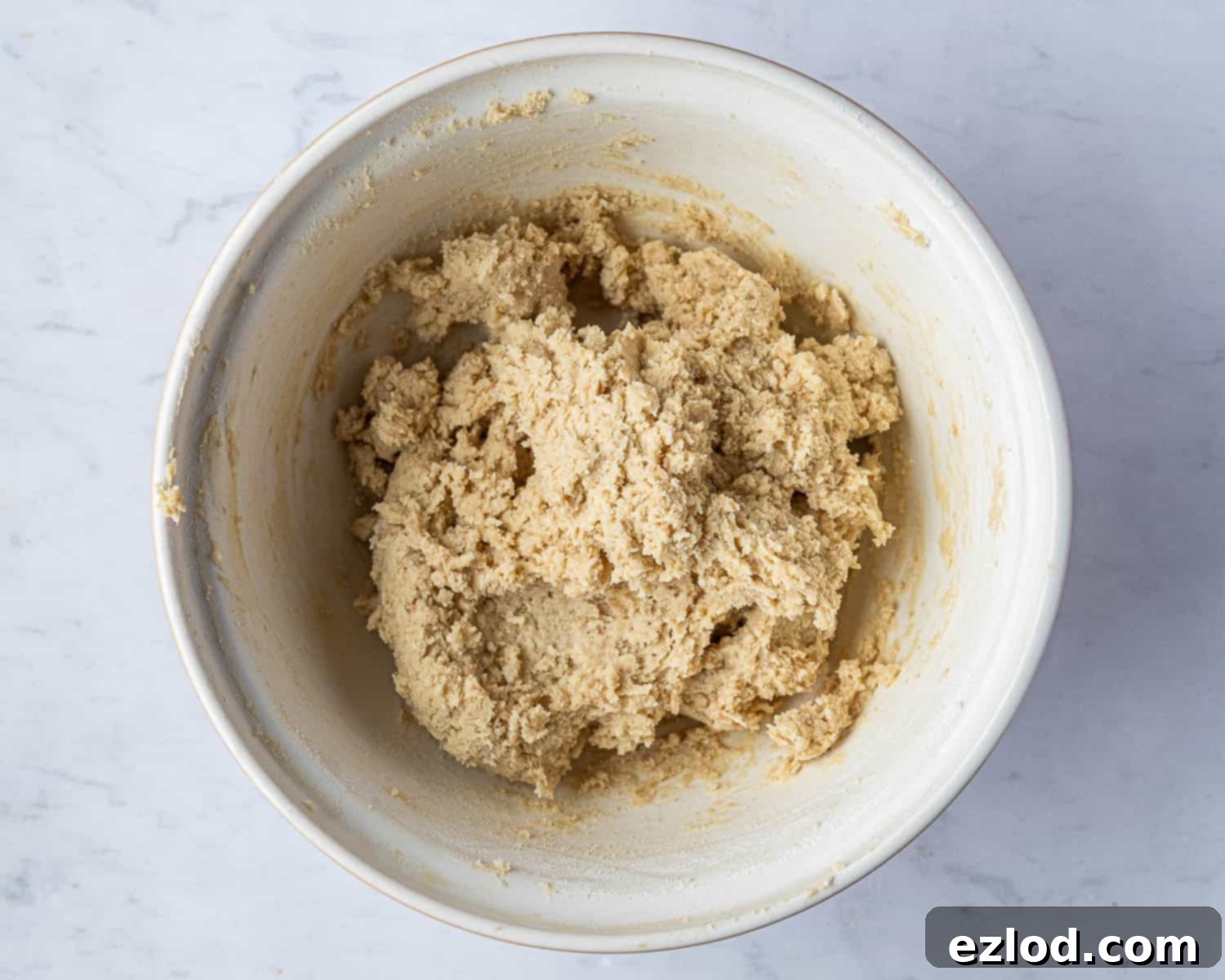
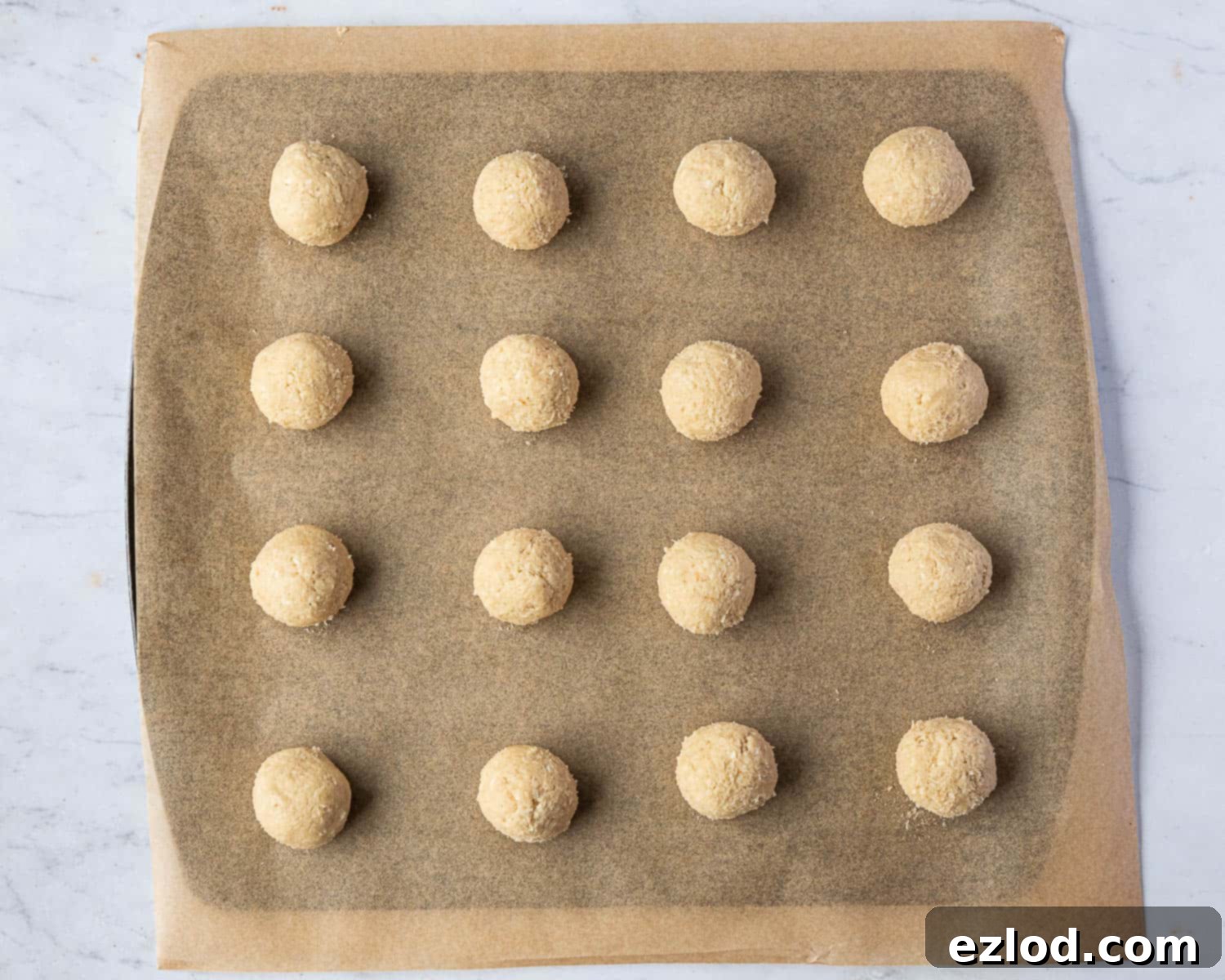
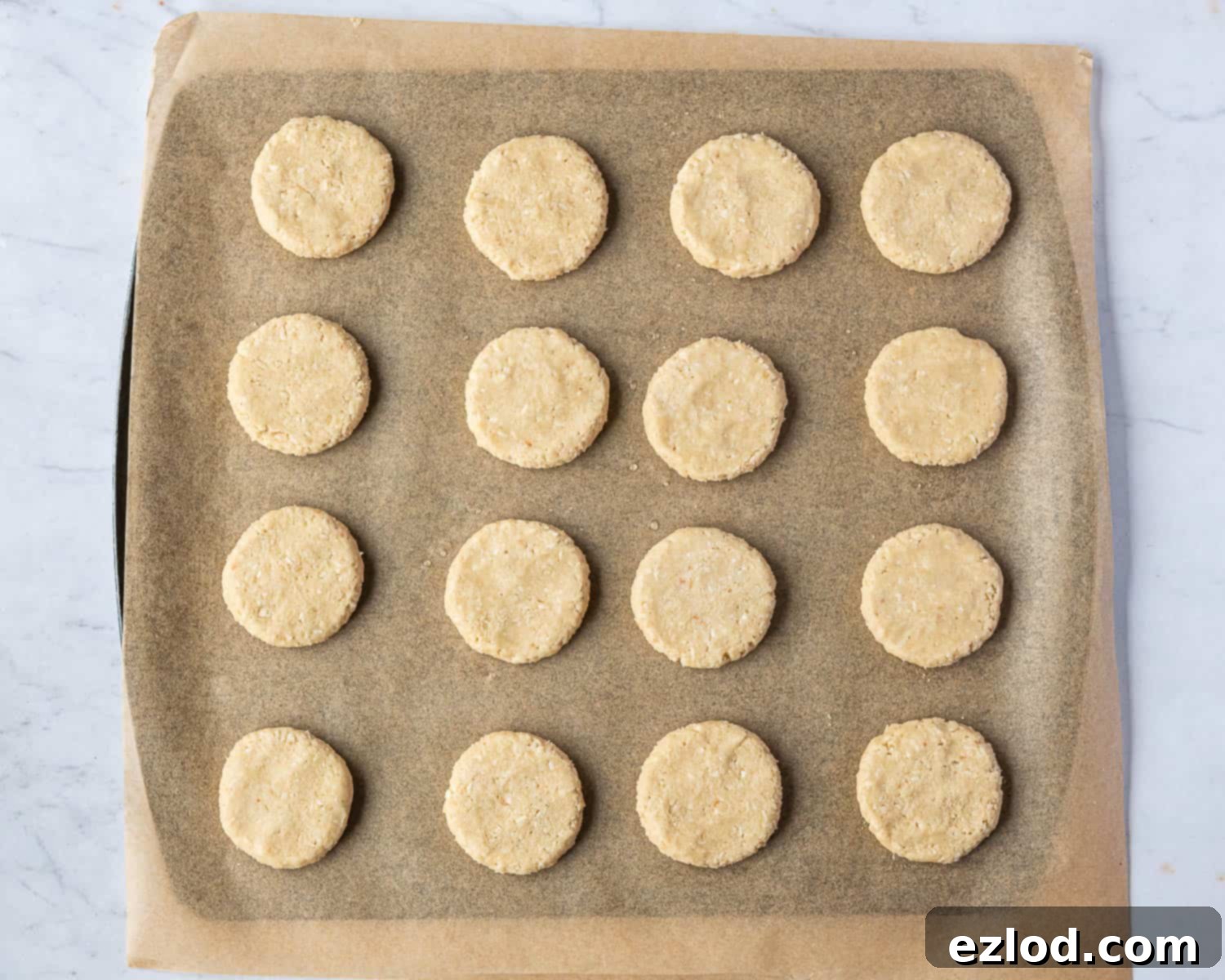
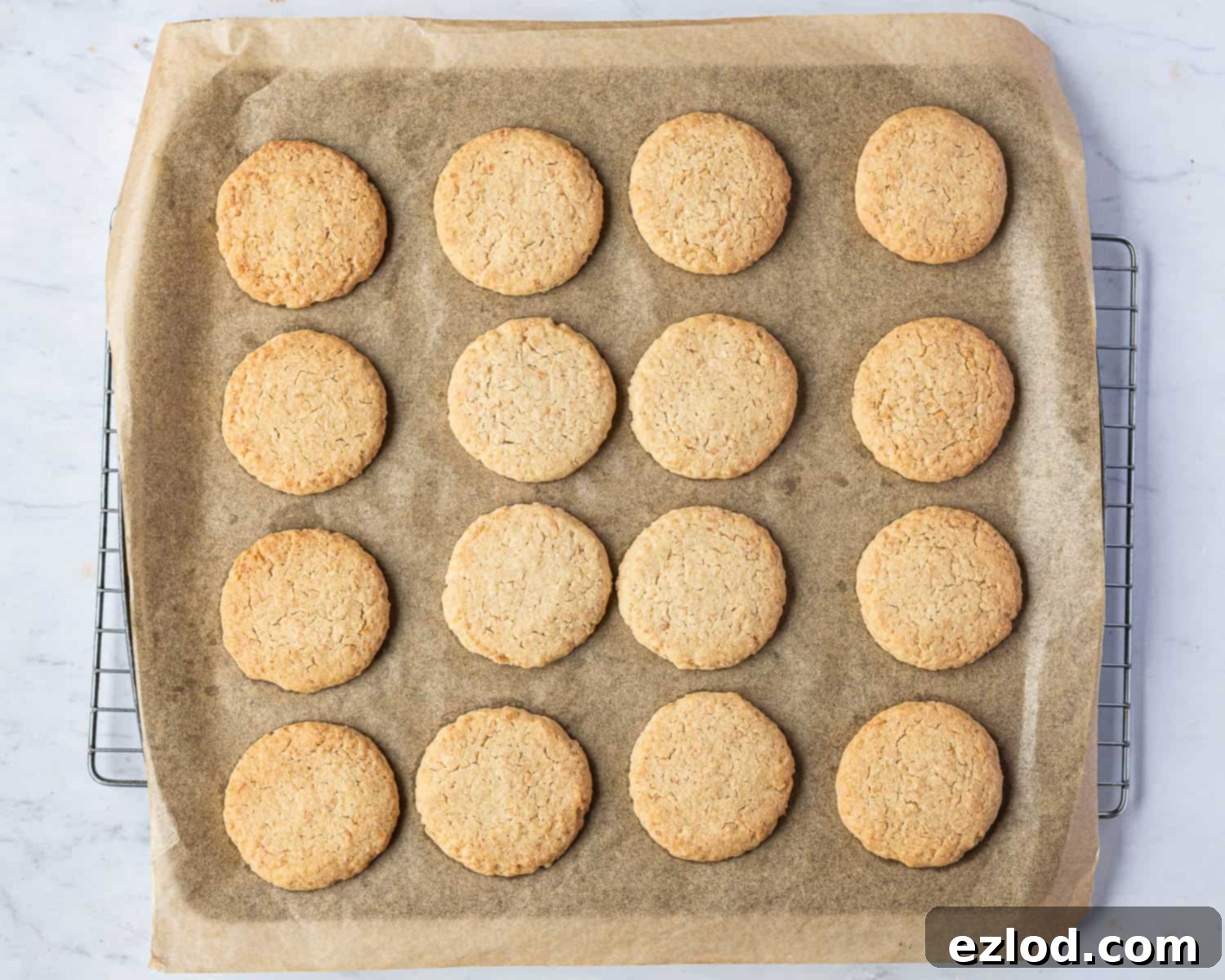
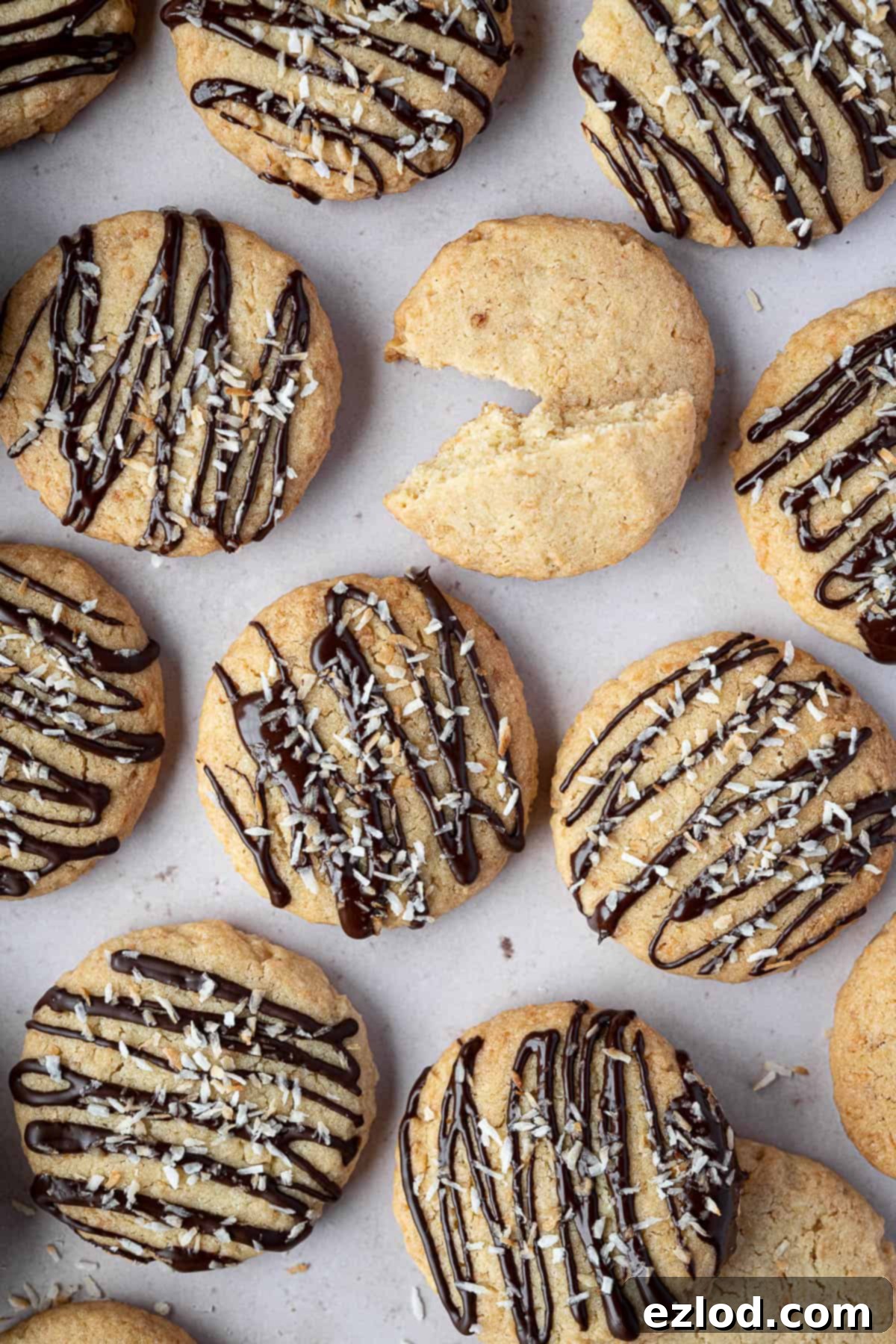
Top Tips for Vegan Cookie Baking Success:
Achieving perfect vegan coconut cookies every time is easy with a few expert tips:
- Embrace Metric Measurements: As with all my baking recipes, I wholeheartedly recommend using metric measurements with a digital scale rather than relying on cup conversions. Cups are notoriously inaccurate as a measuring system, leading to inconsistencies in your results. A digital scale ensures precise ingredient ratios, giving you far better, more consistent cookies. Plus, it’s often less messy and quicker!
- Don’t Overwork the Dough: Once you add the flour, mix the dough just until it comes together and no dry streaks remain. Overworking the dough develops the gluten in the flour, which can lead to tough, chewy cookies instead of the desired tender, shortbread-style texture. A gentle mix is all you need.
- Uniformity is Key: To ensure all your cookies bake evenly and have a consistent texture, make sure they are all the same size. The best way to achieve this is to weigh out each portion of dough. I aim for approximately 32g per cookie. This small step makes a big difference in the final batch.
- Room Temperature Ingredients: Ensure your vegan butter is at the correct room temperature – slightly softened but not melted. This allows it to cream properly with the sugars, incorporating air and creating a lighter texture. Cold butter won’t cream well, and melted butter will result in a greasy dough and flat, overly crispy cookies.
- Cooling is Crucial: Allow your toasted coconut to cool completely before adding it to the butter mixture. If it’s still warm, it can partially melt the vegan butter, leading to a greasy dough that’s difficult to handle and can affect the final cookie texture. Similarly, let the baked cookies cool completely on a wire rack before drizzling with chocolate or storing; this allows them to firm up and prevents the chocolate from melting.
- Oven Temperature Matters: Ovens can vary. If you find your cookies are browning too quickly or not enough, consider investing in an oven thermometer to ensure your oven is truly at the temperature you set. Consistent oven temperature is vital for consistent baking results.
Storage and Make-Ahead Instructions:
These vegan coconut cookies are fantastic for making ahead and storing, ensuring you always have a delicious treat on hand:
- Storage: Once completely cooled, these vegan coconut cookies can be stored in an airtight container at room temperature for up to a week. They tend to maintain their crisp exterior and soft interior beautifully.
- Make-Ahead Dough (Refrigeration): The cookie dough itself is quite forgiving and can be prepared in advance. Simply cover the bowl with plastic wrap or transfer the dough to an airtight container and refrigerate for up to three days. When ready to bake, let it sit at room temperature for 10-15 minutes to soften slightly before rolling and shaping.
- Make-Ahead Dough (Freezing): For longer storage, you can freeze the shaped cookie dough. Prepare the dough and roll it into balls, then flatten them as per the recipe instructions. Arrange the flattened cookies on a baking sheet and freeze until they are solid. Once frozen, transfer the solid cookie discs to an airtight container or a freezer-safe bag. They can be stored in the freezer for up to 3 months. When you’re ready to bake, you can cook them directly from frozen; they may just require an additional minute or two in the oven compared to fresh dough. This is a fantastic way to enjoy freshly baked cookies whenever the craving strikes!
More Delicious Vegan Cookie Recipes to Explore:
If you’ve enjoyed these vegan coconut cookies, you’ll love exploring other plant-based delights from my collection. Here are some more fantastic vegan cookie recipes to tempt your taste buds:
- Vegan Easter Biscuits
- Vegan Lemon Sandwich Cookies
- Vegan Vanillekipferl (Vanilla Crescent Cookies)
- Chunky Chocolate Pecan Cookies (Vegan)
- Vegan Chocolate Orange Shortbread
- Vegan Peanut Butter Cookies
- Vegan Oatmeal Raisin Cookies
- Pumpkin Spice Shortbread (Vegan)
- Vegan Cranberry Orange Shortbread
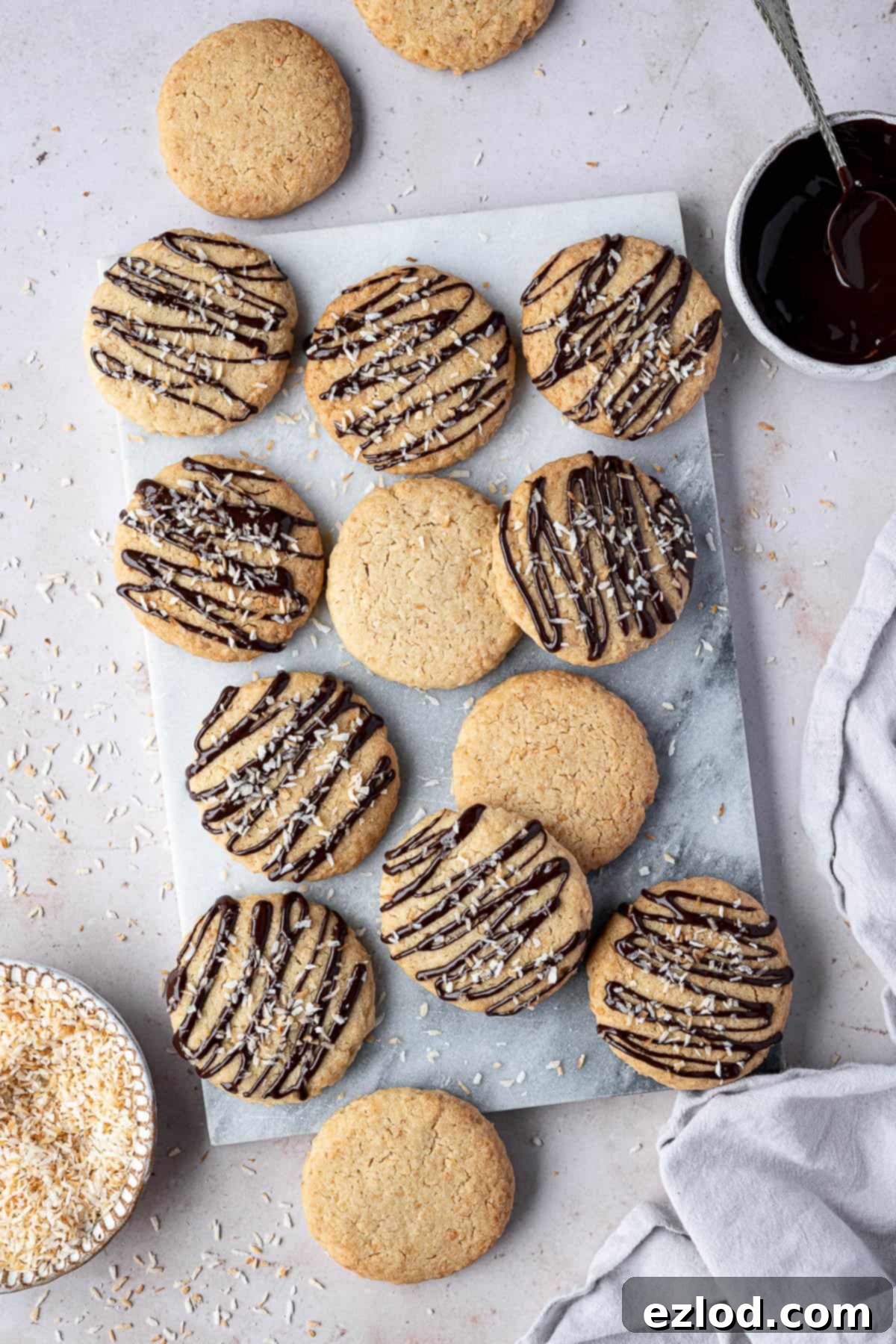
If you tried this recipe and loved it, I’d be thrilled to hear from you! Please rate it, leave a comment below, or tag @domestic_gothess on Instagram and hashtag it #domesticgothess to share your beautiful creations!
All images and content on Domestic Gothess are copyright protected. If you wish to share this recipe, please do so by using the provided share buttons. Do not screenshot or post the recipe or content in full; instead, kindly include a direct link back to this post for the complete recipe. Your understanding and support are greatly appreciated!

Vegan Coconut Cookies
Ingredients
- 100 g (1 ¼ cups) desiccated coconut (plus extra for sprinkling)
- 200 g (¾ cup + 2 Tablespoons) vegan block butter (NOT the spreadable kind. I use Naturli Vegan Block) slightly softened)
- 70 g (⅓ cup + 2 teaspoons) caster or granulated sugar
- 70 g (⅓ cup) light brown soft sugar
- 1 teaspoon vanilla extract
- 2 Tablespoons unsweetened non-dairy milk (I use soy)
- 275 g (2 ¼ cups) plain (all-purpose) flour
- 100 g (3 ½ oz) dark chocolate melted
Instructions
-
Preheat the oven to 180°C/160°C fan/350°F/gas mark 4. Line two baking sheets with baking parchment.
-
Spread the desiccated coconut out in a wide skillet or frying pan over a low heat. Stir until it turns golden then remove from the heat, tip into a bowl and set aside to cool.
-
Cream together the vegan butter, caster and light brown soft sugars, vanilla extract and milk with an electric mixer until fluffy and well combined.
-
Stir in the cooled toasted coconut. Finally mix in the flour until fully combined.
-
Roll the dough into 23 balls, about a rounded Tablespoon each, or 32g (I prefer to weigh them out). If the dough is too soft to roll, cover the bowl and pop it in the fridge for half an hour to firm up a bit.
-
Place the balls of dough well spaced apart on the lined baking sheets.
-
Use your fingers to flatten the balls of dough; they don’t spread out much in the oven so flatten them to the thickness you would like your cookies, I go for about 1cm.
-
Bake for about 20 minutes, until pale golden.
-
Transfer the baked cookies to a wire rack and leave to cool completely.
-
Once cool, drizzle with melted chocolate and sprinkle with some extra toasted coconut if you like.
Notes
- For comprehensive tips, detailed insights, and step-by-step photos that guide you through the process, please refer to the main article above the recipe card.
- To ensure the most consistent and accurate results in all your baking endeavors, I highly recommend using metric measurements with a digital kitchen scale over volumetric cup conversions. Measuring by weight is far more precise and can significantly improve the outcome and consistency of your baked goods. It’s also often cleaner and quicker!

